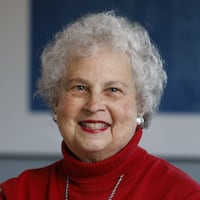How to go
What: Fourth Annual Neighborhood Ramadan Fast Breaking
When: 7 p.m. Tuesday, Sept. 7
Where: The Islamic Center of Dayton, 2277 Maue Road, Miamisburg
Program: Discussion of “What is Shariah” by Wayel Azmeh, M.D. followed by questions, breaking the fast, prayers and dinner
Cost: Free
Reservations: Dinner seating is limited, reservations are required by noon on Monday, Sept. 5. Please respond to: daytonmercy@yahoo.com
The origins of Islam in Dayton date back to 1933 and the Ahmadiyya movement. The group’s first mosque, completed in 1965, was built at 633 Randolph St.
Another Muslim group, Nation of Islam, dates back to 1965 and met at 1517 W. Fifth St. in a house called Muhammad’s Mosque No. 19.
Today, four Sunni mosques are thriving in the Greater Dayton area: the Dayton Mercy Society/Islamic Center, 2277 Maue Road in Miamisburg, the Islamic Society of Greater Dayton at 26 Josie St. in Dayton’s Oregon District, the Masjid-At-Taqwa mosque at 710 N. Broadway St., and Al-Islam, 3958 Salem Ave., is located above Abdul’s African Arts.
At The Dayton Islamic School in Beavercreek, youngsters (pre-school through eighth grade) study Arabic and Islamic traditions as well as secular subjects.
“All of the Dayton mosques are growing and have plans for expansion,” says Abdulah Johnson, who is active in the local Muslim community.
Down the road in West Chester is the Islamic Center of Greater Cincinnati, one of the largest mosques in the state, which you may have spotted from the road. The mosque offers a “Tours & Talks” guided tour for first-time visitors (www.icgc.info/).
Outreach by the local Muslim community ranges from active participation in interfaith organizations such as the Greater Dayton Interfaith Trialogue and the National Conference of Community and Justice to health fairs and cultural programs. The Muslim Clinic of Ohio offers free medical services to all patients who have no insurance. It’s staffed by 15 primary-care physicians and has been run by the Dayton Mercy Society since 2008.
Four years ago, the Mercy Society also began hosting a community dinner commemorating the end of Ramadan. This year the event is slated for Tuesday night, Sept. 7. The public is invited, and the event is free.
“I would encourage people not to blindly go along with some of this hysteria we’re seeing nowadays, but to stop and question,” says Karen Dabdoub, executive director of the Southern Ohio region for the Council on American-Islamic Relations (CAIR). “If you don’t know any Muslims, go and talk to them and find out for yourself.”
If you would like to visit a local mosque, it’s best to go on a Friday afternoon when congregational prayers are recited.
“It’s best to call first as a courtesy,” advises Johnson.
It’s customary to remove your shoes at the entrance to the prayer hall. Dress can be casual (jeans permitted), but women should cover their arms, hems should reach below the knees, and a head scarf is traditional.
The Koran, Islam’s holy book, is recited in Arabic.
“The imams (ministers) normally present their talks in both Arabic and English,” says Johnson.
“There is a lot to know,” says Dabdoub. “The basics are that Muslims believe in and worship God and believe in the Biblical prophets and that we practice our religion through prayer, charity and fasting. Those are three of the five pillars of Islam. The others are declaration and pilgrimage: Once in our life, if we can, we go to Mecca to visit the Holy places.”
SOURCES: Dayton History, Wright State University Libraries, Council on American-Islamic Relations
About the Author

